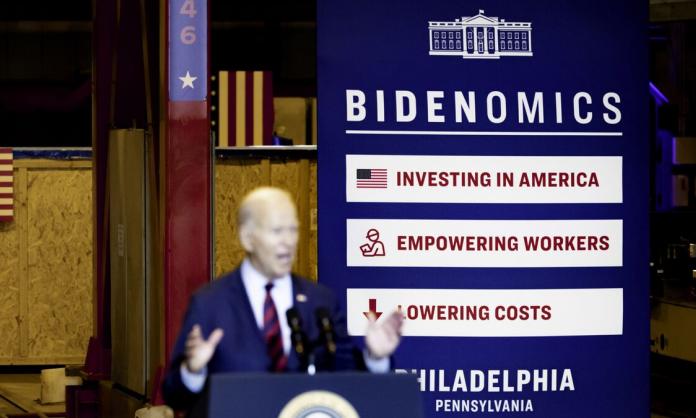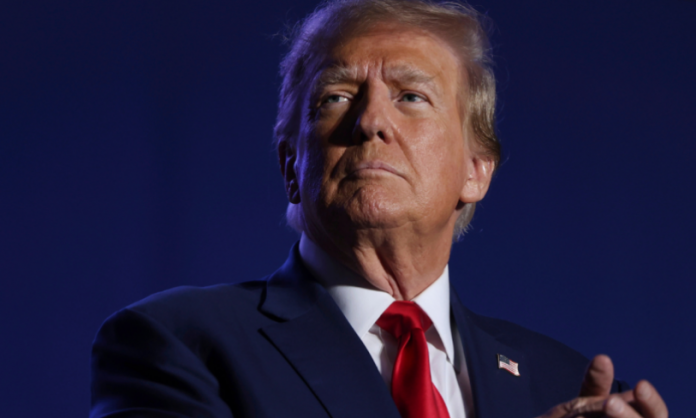Joel Geier has been a socialist activist in the United States since the civil rights movement in the late 1950s and Berkeley free speech campaign in the 1960s. He has written extensively on American politics, the Democratic Party, economics and imperialism. Joel spoke to Eleanor Morley while in Australia last month about the Biden administration’s attempt to strengthen American empire.
--------------------
The race to the 2024 US presidential election is well and truly under way, and Joe Biden appears to be making his economic program the centrepiece of his re-election campaign. Could you explain what this program, dubbed “Bidenomics”, is all about?
Biden’s economics are not separate from his foreign policy. This is guided by the fact that the United States is no longer the sole superpower: it has a competitor—China. And China has become more effective on the world market; it is the top trading partner for 120 countries. That’s an enormous shift from twenty years ago. For almost all of those countries, the top trading partner would once have been the United States.
There is a new struggle for world domination. It has some flashpoints, like Taiwan or the South China Sea, but it’s also economic. For instance, China has set up the Belt and Road Initiative, which is an attempt to integrate the Eurasian market under Chinese domination.
The United States has started to act against that. First was the pivot to Asia, which was Obama’s attempt to start modernising the American armed forces, including a $1 trillion modernisation of nuclear weapons. But it didn’t in any way change the big dynamics.
Next, Trump comes in and starts a trade war with China that is chaotic, incompetent, a failure. But it does bring to public consciousness the struggle with China. Trump also begins the first round of economic sanctions, most notably against Huawei.
Then the Biden administration enters with the following proposition: neoliberalism is a failure; we have to change the economics of what’s going on in order to compete against China. The administration has proposed a new industrial policy: a series of measures to expand the American economy so that it is capable of taking on China.
There are three key measures: infrastructure, subsidies for “green energy” (things like electric vehicles and solar panels) and sanctions on Chinese semiconductors and other high-tech commodities to slow down the progress of the Chinese economy.
The Biden administration was already leaning this way before the election—you could see this in articles written by National Security Adviser Jake Sullivan. But the COVID pandemic and invasion of Ukraine pushed even harder in that direction.
COVID caused a massive disruption of supply chains. You couldn’t get masks—they were made in China. You couldn’t get ventilators. Many of the pharmaceutical drugs and medical equipment the US needed are made in China. That focused the mind during the pandemic.
And this spread to other parts of the economy. Parts of it shut down because companies couldn’t access inputs from China. The auto industry, all sorts of military equipment, much of it relies on supply chains that lead back to China. Concerns about this had been going on for some years, but all of a sudden it became very clear that the American economy is dependent upon decisions made by the Chinese Communist Party. What?! Why did you fight the Cold War for 50 or 60 years?
And then comes the war in Ukraine. And one of the things that they learnt from this is that the United States no longer has the military-industrial complex capable of carrying out a long-term war. That now has to return to US soil. The US became the dominant imperialist power in World War Two because it was the “arsenal of democracy”; it produced all the planes, ships, tanks, guns and bullets for the Allies. Without this, the Allied war effort would have failed. This is no longer the case. Overall, the United States no longer has the military-industrial complex it needs to take on a war with China for world domination.
China has 50 percent of all the world’s shipyards; the United States has 1 percent. The US made thousands of ships in World War Two; it is no longer capable of doing so. Instruments for military planes are made in China; security cameras for US military bases are made in China; the list goes on.
The Biden administration is now attempting to start the process of rebuilding the American industrial and military complex. It is focused on world domination. That’s what its economic program is about.
What has the Biden administration done to try revive America’s industrial base?
Trump and the Republicans gave money directly to corporations that they presumed would then invest it. It was a total failure. The Biden administration is still giving money to corporations but in a different way.
The first is through investment in infrastructure—roads, railroads, harbours, bridges—all of which have been allowed to decay. Everyone is for that, but it’s still a subsidy to corporations because it’s designed to improve the transportation and circulation of goods. You can make more profit if you have a good railroad.
The second thing is subsidising green energy: electric vehicles, solar panels and things like that. Why are they doing this? The United States is now the leading oil producer in the world, but it wants to have enough oil to be able to export to its allies. This is not just for the profits of the oil companies, but will be a necessity if there’s war.
The US produced 80 percent of the oil used by the Allies in World War Two. Much of its military plans were designed to keep Germany from accessing the Romanian oil fields, and to keep Japan from getting oil. That’s what some of this is about. The United States now produces 20 million barrels of oil and gas; it has gone from being the biggest importer of oil a decade ago, to now exporting some oil. It wants to be able to do more of this as it prepares for the future.
The third thing is to prevent China from accessing high-tech equipment, like advanced semiconductors. If the United States is dependent upon China for lots of things, China is dependent on American high tech. Its economy and war machine depend upon it.
As a result of the war in Ukraine, the US has re-established itself in Europe, so much so that it is now preventing the Europeans from sending high-tech semiconductor inputs to China. For example, the Americans have now prevented the Dutch company Advanced Semiconductor Materials Lithography from sending ultraviolet lithography machines, which are needed for building semiconductor machines, to China. It takes away a good chunk of their market, but the Americans forced it through.
Biden hasn’t presented these measures to the American public as though they are just about beefing up industry and the military—he has pitched it as a new dawn for the working class, as a return to the New Deal. Are American workers getting anything out of the subsidies?
Biden presents the program as though it will be good for workers, who will be able to get a well-paid union job without needing a college degree. But it is not a subsidy to the poor, it is a subsidy to the corporations through the expansion of the US economy. While it may lead to more industrial jobs, it’s not putting any money in any workers’ pockets right now. But that’s not how Biden is talking about it.
The Democratic Party has not raised the economy as an issue in elections in years. The 2020 election, for example, was COVID from the vantage point of the Democrats, the economy from the vantage point of the Republicans. In 2022, the Republicans argued against the Democrats on inflation, and the Democrats argued for abortion. For the first time in decades, Biden is attempting to make the economy a Democratic Party issue again.
The Democratic Party vote used to be based on the working class. American workers in the 1940s, ’50s, ’60s and into the ’70s voted more for the Democratic Party than British workers voted for the Labour Party in Britain, or German workers voted for the Social Democratic Party. The Democratic Party was the party of social security, of unemployment insurance, of a minimum wage and then of Medicare. But then they totally adopted neoliberalism, and there have been no reforms in 50 or 60 years. There have been some changes: equal marriage, abortion and so on, but economically there has been nothing. Wages for industrial workers have not gone up in 50 years.
The result for the Democratic Party has been immense. For instance, the state that was most heavily Democratic was West Virginia—the coal miners. It is now the second most heavily Republican state. The Democratic Party abandoned the working class to hitch its wagon to neoliberalism and globalisation. So, they started to lose workers’ votes, since they could not run on working-class issues.
Republicans started to make different arguments to workers—that the elites think they’re contemptible, which is actually true of the Democratic Party. It’s the party of the upper middle class, of the professionals, doctors, lawyers, professors. The party represents the top 5 or 10 percent of the population—it is totally contemptuous of the working class. It’s for making some amelioration for the poorest people, but the minimum wage today is lower than it was in 1968.
So they started losing the white working class, but they could say, “That’s because they’re racist, we’re going to run on diversity and equity, and we have demographics on our side—the country will no longer be majority white because of the growing Hispanic and Asian population”. And then they started to lose the Hispanic working class, then the Asian, and now 20 percent of the Black population are voting Republican.
The Republicans have also picked up on the Democrats’ identity politics and are running Black and Hispanic candidates. For example, of the eight or nine people who are running in the Republican presidential primary, one is Black, Tim Scott, two are Indian Americans, Nikki Haley and Vivek Ramaswamy.
So the Democratic Party all of a sudden has come to the conclusion that they’re not going to have a natural majority and they need to go back to winning the working class. This is their program, or their opening program, to try win the working class.
How effective has Bidenomics actually been?
Well, there’s a capital boom going on in the United States. A lot of it is European capital, and the auto industry, like Toyota, Nissan, Volkswagen, BMW, they’re starting to build factories in the United States because of the subsidies for electric vehicles.
Then there are the subsidies for semiconductors. Semiconductor plants are being built by Taiwan Semiconductor Manufacturing Corporation, Samsung, Intel and so on. This is all one of the reasons why the rise in interest rates has not raised unemployment and cut consumption.
So, the program is working in that sense—it’s reinvigorating at least sections of American industry. I think that from the vantage point of American imperialism, it’s the most successful administration in 30 years. It has re-established its power in Europe. It is doing so in the Pacific, with Japan, South Korea, Australia, the Philippines, many of the Pacific islands. It still has to re-establish its ties in Latin America and in Africa, but it has been very quick to achieve this in just two to three years.
But it’s not enough to convince workers—they don’t necessarily see their living standards going up. You could say in the long run they may, but in the long run, we’ll all be dead, as Keynes said. They have not come up with anything that immediately raises the standard of living of the working class, which is why Trump is still viable, and why Biden is unpopular.
We’re in a world of much greater instability—economically, politically, militarily, any way you want to see it—than what has gone on for decades. This is becoming a totally different period than the 40 years of neoliberalism and globalisation. And that’s particularly true in the United States.










